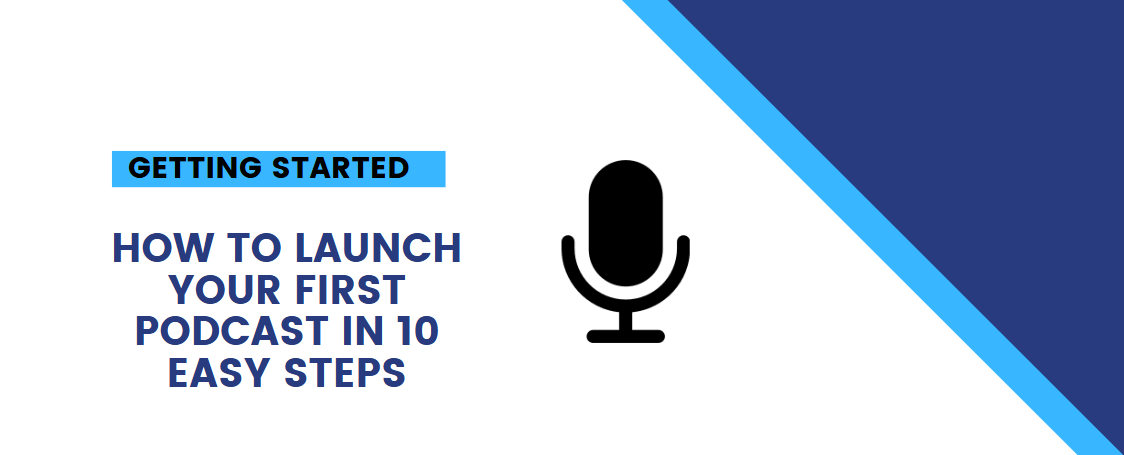Podcasting is booming! In 2023, over 500 million people listen to podcasts worldwide. Whether you want to share your passion, tell stories, or build a brand, starting a podcast can be an exciting journey. But where do you begin? Don’t worry! In this blog, we’ll break it down into 10 easy steps to help you launch your first podcast. Let’s dive in!
Step 1: Find Your Niche
First things first: you need to find your niche. What are you passionate about? What do you want to talk about for weeks, months, or even years?
According to a study by Edison Research, 44% of the U.S. population has listened to a podcast in the past year, and the variety of topics is vast. From true crime to cooking, there’s a podcast for everyone. Consider what excites you. Is it travel, technology, or personal development? Finding your niche will help you attract a dedicated audience.
Tip:
Spend some time brainstorming. Write down all your interests and expertise. Look at existing podcasts in those areas to see what’s already out there and how you can add your unique spin.
Step 2: Define Your Audience
Once you have your niche, it’s time to define your audience. Who do you want to reach? Knowing your audience helps shape your content, style, and marketing strategies.
Stat Alert: A survey by Podcast Insights shows that 18-34-year-olds make up the largest demographic of podcast listeners. But don’t forget about other age groups—there are plenty of older listeners too! Think about who would benefit most from your content and tailor your podcast for them.
Tip:
Create a listener persona. What are their interests? Where do they hang out online? This can help you connect better with your audience.
Step 3: Choose a Format
Now that you know your niche and audience, it’s time to choose a podcast format. There are several popular formats to consider:
- Interview: Invite guests to share their insights.
- Solo: Share your thoughts and expertise alone.
- Panel: Discuss topics with a group of people.
- Storytelling: Craft narratives around specific themes.
According to a report by Podchaser, 66% of podcasts feature interview formats. Pick the one that suits your style and content best!
Tip:
Think about how long your episodes will be. The average podcast episode is around 30-60 minutes. Choose a length that fits your content and audience’s preferences.
Step 4: Name Your Podcast
Next up, you’ll need a catchy name. Your podcast’s name should be memorable, descriptive, and easy to spell.
Fun Fact: A name that’s too long or complicated can make it hard for people to find you. Aim for something concise—ideally under 30 characters.
Tip:
Check if your podcast name is available on platforms like Apple Podcasts and Spotify. You also want to see if the domain name is available if you plan to create a website.
Step 5: Create Cover Art
Your podcast cover art is the first thing potential listeners will see. It needs to stand out and convey what your podcast is about.
A study by Podcast Host shows that 70% of listeners choose a podcast based on its cover art. Make sure yours is eye-catching and professional. You can use tools like Canva or hire a graphic designer to create it.
Tip:
Keep it simple! Use bold colors and clear fonts. Make sure it looks good in both small and large sizes.
Step 6: Plan Your Episodes
Planning your episodes in advance can save you time and help you stay organized. Consider creating a content calendar with topics, guest schedules, and recording dates.
Stat Alert: According to a survey by the Podcast Host, 41% of podcasters plan their episodes out at least a month in advance. This helps in maintaining consistency and quality.
Tip:
Outline each episode’s main points. This doesn’t have to be a full script, but having a structure can keep you on track during recording.
Step 7: Gather Your Equipment
Now it’s time to get the gear! You don’t need to spend a fortune to start podcasting. Here’s a basic list of what you’ll need:
- Microphone: A good-quality microphone is essential. USB microphones like the Blue Yeti or Audio-Technica ATR2100x are great options for beginners.
- Headphones: Use closed-back headphones to monitor your audio while recording.
- Recording Software: Free options like Audacity or GarageBand are user-friendly for beginners.
Stat Alert: Studies show that good audio quality can lead to a 92% higher listener retention rate. So, investing in a decent microphone is worth it!
Tip:
Consider recording in a quiet room with minimal background noise. You can also use blankets or pillows to dampen sound if you don’t have a dedicated space.
Step 8: Record Your Episodes
It’s showtime! When you’re ready to record, take a deep breath and relax. Here are some tips for recording:
- Warm up: Do a quick vocal warm-up to help you sound your best.
- Stay hydrated: Keep water nearby to avoid a dry throat.
- Record multiple takes: Don’t hesitate to record several takes to capture the best content.
Fun Fact: Many successful podcasters record in batches. This means recording multiple episodes in one sitting. It can be a time-saver!
Tip:
Try to minimize filler words like “um” and “uh.” If you stumble, just pause, breathe, and continue. You can edit out mistakes later.
Step 9: Edit Your Podcast
Editing can seem daunting, but it’s where you polish your content. Focus on cutting out long pauses, mistakes, or irrelevant tangents.
Free editing software like Audacity or GarageBand can be very helpful. You can also use services like Descript, which offer easy audio and text editing features.
Stat Alert: A survey by The Podcast Host found that well-edited episodes can increase listener satisfaction by up to 30%. Quality matters!
Tip:
Consider adding intro and outro music to give your podcast a professional touch. Just make sure you have the rights to use any music you choose.
Step 10: Publish and Promote Your Podcast
Congratulations, you’ve made it to the final step! Now it’s time to publish your podcast and get the word out. Here’s how:
- Choose a Podcast Hosting Platform: Services like Libsyn, Podbean, or Anchor can host your podcast episodes and distribute them to platforms like Apple Podcasts, Spotify, and Google Podcasts.
- Submit Your Podcast: Follow the guidelines for each platform to get your podcast listed.
- Promote on Social Media: Use platforms like Instagram, Twitter, and Facebook to share your episodes. Engaging visuals and short clips can help attract listeners.
- Engage with Your Audience: Respond to comments, ask for feedback, and create a community around your podcast. Building relationships with listeners can lead to loyal followers.
Fun Fact: Podcasts with a dedicated social media presence grow their audience 50% faster than those that don’t engage online.
Tip:
Consider creating a website for your podcast. This can serve as a hub for show notes, episode links, and listener engagement.
Conclusion
Launching your first podcast may seem like a big task, but by following these 10 easy steps, you can turn your idea into reality. Remember to stay patient and consistent. Podcasting is a journey, and growth takes time.
As you start this exciting adventure, keep learning and adapting. According to a study by Statista, there are now over 2.4 million podcasts out there, but with your unique voice and perspective, you can carve out your own space.
So, grab your microphone and get started! The world is ready to hear what you have to say. Happy podcasting!


